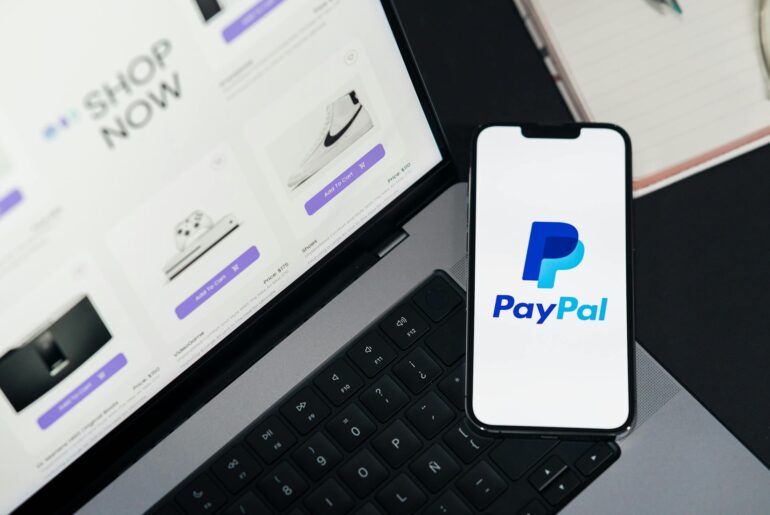This article may contain references to products or services from one or more of our advertisers or partners. We may receive compensation when you click on links to those products or services. Nonetheless, our opinions are our own.
The information presented in this article is accurate to the best of our knowledge at the time of publication. However, information is subject to change, and no guarantees are made about the continued accuracy or completeness of this content after its publication date.
PayPal is still a well-known leader in the world of digital payments, and investors and analysts are always paying attention to it. The company’s strong financial base and creative approach to financial services have kept it popular, even though the stock market has gone up and down.
Shorting out-of-the-money (OTM) puts has become a popular way for people to make money while keeping their risk low. This method not only lets investors make money from premiums, but it also gives them the chance to buy PayPal shares at a lower price. If you want to improve your portfolio, it can be helpful to know why PayPal has been so successful for so long and how this options strategy works.
- Why Analysts Continue to Favor PayPal Stock
- The Strategy Behind Shorting Out-of-the-Money Puts
- Advantages of Shorting OTM Puts
- Balancing Risk and Reward in Options Trading
- Executing a Short OTM Put Strategy
- Final Thoughts
- Frequently Asked Questions
- What does it mean to short an out-of-the-money (OTM) put option?
- Why would investors short OTM puts on PayPal?
- What is the benefit of selling puts instead of buying PayPal stock directly?
- What happens if PayPal’s stock price falls below the strike price?
- Is shorting puts risky?
- How is the effective purchase price calculated when assigned?
- What is the best time to sell OTM puts?
- Can you lose money selling OTM puts?
- How do you choose the right strike price and expiration?
- Is shorting puts suitable for all investors?
- Does shorting puts generate taxable income?
- Recommended Reads
Why Analysts Continue to Favor PayPal Stock
Several factors contribute to PayPal’s standing as a preferred investment choice among financial analysts. Its expanding market reach, commitment to innovation, and strong earnings performance make it a stock worth considering.
- Rising Adoption of Digital Payments: With businesses and consumers increasingly moving away from cash transactions, PayPal benefits from steady demand for its services.
- Diversified Financial Offerings: PayPal has expanded beyond traditional payment processing, now offering credit solutions, cryptocurrency transactions, and business lending services.
- Consistent Financial Performance: The company regularly reports strong earnings, maintaining attractive financial metrics such as return on equity (ROE) and free cash flow.
These attributes solidify PayPal’s role as a major player in the financial technology sector, making it an appealing stock for investors who seek exposure to the growing digital finance industry.
The Strategy Behind Shorting Out-of-the-Money Puts
Shorting OTM puts involves selling put options with a strike price below the current market price of the stock. This strategy allows investors to earn a premium while potentially acquiring shares at a reduced cost if the stock price declines. It is often used by those who believe in a company’s long-term potential but prefer an alternative to directly purchasing shares at market value.
Advantages of Shorting OTM Puts
- Premium Income Generation: Investors collect immediate income by selling put options, providing a consistent cash flow opportunity.
- Potential for Discounted Share Acquisition: If the stock price drops below the strike price, investors may purchase shares at an effective price lower than the market rate.
- Lower Upfront Investment: Selling puts requires less initial capital than outright stock purchases, making it a strategic way to gain exposure to a stock with less immediate financial commitment.
Below is an example of how an investor might structure a short OTM put position for PayPal:
| Strike Price | Premium Received | Effective Purchase Price (if assigned) |
|---|---|---|
| $80 | $2.50 | $77.50 |
| $75 | $3.00 | $72.00 |
This approach allows traders to capitalize on stock stability while maintaining an entry plan should the stock price move lower.
Voted "Best Overall Budgeting App" by Forbes and WSJ
Monarch Money helps you budget, track spending, set goals, and plan your financial future—all in one app.
Get 50% OFF your first year with code MONARCHVIP
Balancing Risk and Reward in Options Trading
While shorting OTM puts can be a profitable endeavor, it is essential to understand the associated risks. Investors need to be prepared for potential declines in the stock price, which could lead to significant losses if the stock drops well below the strike price. Additionally, broader market conditions and company-specific developments can impact the effectiveness of this strategy.
Considerations for Managing Risk
- Evaluating Market Conditions: Broader economic trends, interest rates, and sector performance can influence stock prices and option premiums.
- Understanding Risk Exposure: Selling puts carries the obligation to buy shares if the stock falls below the strike price, requiring careful assessment of position sizing.
- Timing the Trade: Option premiums are typically higher during periods of increased market volatility, making timing an important aspect of maximizing returns.
The table below illustrates different potential outcomes for a short put position:
| Market Outcome | PayPal Price at Expiration | Profit/Loss |
|---|---|---|
| Above Strike Price | $150 | +$250 (premium collected) |
| At Strike Price | $145 | $0 (premium offsets loss) |
| Below Strike Price | $140 | -$500 (minus premium) |
By maintaining a disciplined approach, investors can manage downside risk while capitalizing on the income-generating potential of short puts.
Executing a Short OTM Put Strategy
For those looking to implement this strategy effectively, following a structured process can improve the likelihood of success.
Steps to Consider When Selling OTM Puts
- Analyze Market Trends: Research PayPal’s stock performance, earnings reports, and broader economic factors.
- Select a Suitable Strike Price: Identify a price level that balances risk and reward while aligning with the investor’s market outlook.
- Choose an Expiration Date: Short-term expirations tend to have lower risk, while longer-term contracts offer higher premiums but greater exposure.
- Monitor Premiums and Volatility: Selling puts during periods of market uncertainty often results in higher premiums.
- Maintain Risk Management Protocols: Ensure that sufficient capital is available in case shares are assigned.
For instance, if PayPal is trading at $100, an investor might sell a put option with a $95 strike price, collecting a $3 premium per share. If assigned, the effective purchase price would be reduced to $92 after factoring in the premium.
Final Thoughts
PayPal is still a great investment choice because it is a leader in the digital payments industry, offers a wide range of services, and has a strong financial track record. Shorting OTM puts can be a good way for investors to take advantage of this strength and make extra money at the same time.
This options strategy has some great benefits, but managing risk is still an important part of being successful. Investors should take a close look at the market, keep an eye on how their stocks are doing, and make sure their portfolio can handle any price changes that might happen. Shorting OTM puts can be a useful part of a diversified investment strategy if you plan ahead.
Frequently Asked Questions
What does it mean to short an out-of-the-money (OTM) put option?
Shorting an OTM put means selling a put option with a strike price below the current market price of the stock. The seller receives a premium upfront and agrees to buy the stock at the strike price if the buyer exercises the option.
Why would investors short OTM puts on PayPal?
Investors who are bullish on PayPal may short OTM puts to earn premium income while potentially acquiring the stock at a discount if the price drops. It’s a strategy that combines income generation with a value-based approach to stock acquisition.
What is the benefit of selling puts instead of buying PayPal stock directly?
Selling puts requires less capital upfront than purchasing shares outright. If the option expires worthless, the seller keeps the premium. If assigned, the seller acquires the stock at an effective price lower than the market value, reducing the average cost per share.
What happens if PayPal’s stock price falls below the strike price?
If the stock closes below the strike price at expiration, the seller is obligated to buy the shares at the strike price. The effective cost basis is reduced by the premium collected, but the position could result in a paper loss if the stock drops significantly.
Is shorting puts risky?
Yes. While the profit is capped at the premium received, the potential loss is significant if the stock falls far below the strike price. Investors must be willing and able to buy the stock or have risk mitigation strategies in place.
How is the effective purchase price calculated when assigned?
Effective Purchase Price = Strike Price – Premium Received
For example, if you sell a $95 put and collect a $3 premium, your effective purchase price if assigned would be $92 per share.
What is the best time to sell OTM puts?
Periods of high volatility generally yield higher premiums, making them ideal for selling puts. Earnings reports, market corrections, or macroeconomic uncertainty can boost implied volatility and option premiums.
Can you lose money selling OTM puts?
Yes. If the stock falls well below the strike price, the loss can be substantial. For instance, if PayPal drops from $100 to $80 and you sold a $95 put, your paper loss would be $15 per share minus the premium collected.
How do you choose the right strike price and expiration?
Choose a strike price below current market value where you’d be comfortable owning the stock. Shorter expirations reduce exposure but offer smaller premiums; longer expirations yield higher premiums but increase risk duration.
Is shorting puts suitable for all investors?
No. This strategy is better suited for experienced investors who understand options, have risk tolerance, and can manage capital obligations if assigned. Margin accounts and sufficient liquidity are typically required.
Does shorting puts generate taxable income?
Yes. Premiums collected are considered short-term capital gains and are taxable in the year they are received. If shares are assigned, the cost basis of the stock will reflect the strike price minus the premium.
Can this strategy be used repeatedly on PayPal?
Yes. Investors often use this strategy in a rolling way, selling new OTM puts after the old ones run out. This can bring in steady money over time, especially with stocks that don’t change much, like PayPal.

Reviewed and edited by Albert Fang.
See a typo or want to suggest an edit/revision to the content? Use the contact us form to provide feedback.
At FangWallet, we value editorial integrity and open collaboration in curating quality content for readers to enjoy. Much appreciated for the assist.
Did you like our article and find it insightful? We encourage sharing the article link with family and friends to benefit as well - better yet, sharing on social media. Thank you for the support! 🍉
Article Title: Why PayPal Stock Continues to Stand Out
https://fangwallet.com/2025/07/22/why-paypal-stock-continues-to-stand-out/The FangWallet Promise
FangWallet is an editorially independent resource - founded on breaking down challenging financial concepts for anyone to understand since 2014. While we adhere to editorial integrity, note that this post may contain references to products from our partners.
The FangWallet promise is always to have your best interest in mind and be transparent and honest about the financial picture.
Become an Insider

Subscribe to get a free daily budget planner printable to help get your money on track!
Make passive money the right way. No spam.
Editorial Disclaimer: The editorial content on this page is not provided by any of the companies mentioned. The opinions expressed here are the author's alone.
The content of this website is for informational purposes only and does not represent investment advice, or an offer or solicitation to buy or sell any security, investment, or product. Investors are encouraged to do their own due diligence, and, if necessary, consult professional advising before making any investment decisions. Investing involves a high degree of risk, and financial losses may occur including the potential loss of principal.
Source Citation References:
+ Inspo
There are no additional citations or references to note for this article at this time.












































